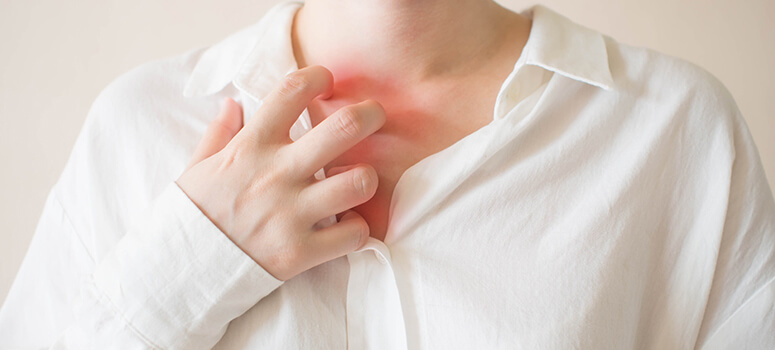In the last few years, global temperatures have consistently risen. In 2020, the earth’s surface temperature was around 0.98 Celsius degrees warmer than the 20th-century average. This rising heat can have negative effects on our body and lead to skin rashes in the summer.
The statistics are proving to be true, and we all know that the heat is only going to get worse this summer. Due to air pollution and global warming, our skin is prone to suffer a lot of damages.
So, it’s time for us to take the right steps towards protecting our skin from possible harm. We address the causes and symptoms of heat rashes, a common skin issue people face during the summer season.
What Is Heat Rash?
Heat rash, which also goes by the names of prickly heat or miliaria, is a common condition where areas of the skin like armpits, chest, neck, etc., develop red rashes which feel prickly and itchy. They look like small goosebumps but with red skin surrounding the bumps.
Heat rashes usually get better once the skin cools off. But if it gets infected by bacteria, then it needs medical attention.
Causes of Heat Rash
heat rashes and other skin problems. Intense warm exercises can also lead to heat rashes. It’s most common in babies because their pores are not completely developed. But adults also prone to it nonetheless.
Heat rashes are caused when the sweat ducts get clogged, and the sweat gets trapped under the skin, which spreads to the nearby tissues causing heat rashes that can be irritating, red, and itchy. The bumps can also get prickly and hence the name prickly heat.
Another reason for heat rashes can be wearing tight clothes that trap the heat and cause profuse sweating. The friction between the inner surface of the skin, like the inner thighs rubbing against each other or the armpits, can also cause heat rashes.
Symptoms of Heat Rash in Kids and Adults
To understand the symptoms of heat rashes, we need to know the different types of heat rashes, based on which the signs and symptoms vary accordingly. There are four types of heat rashes, and they are:
-
Miliaria Crystallina:
It is one of the most common and the mildest forms of heat rashes. They affect the sweat ducts on the top layer of the skin. The bumps that occur are filled with white, crystal clear fluid and are often bubbles of sweat. They are known to burst easily.
-
Miliaria Rubra:
Also known as prickly heat, this type of heat rash is common in kids. It causes more discomfort as it appears on the epidermis or the deeper layer of the skin. They are usually red bumps and are prickly and itchy, which is the reason for discomfort.
-
Miliaria Pustulosa:
It is the second version of the miliaria rubra. When miliaria rubra continues to stay and gets filled with pus (fluid-filled sacs), they are known as miliaria pustulosa.
-
Miliaria Profunda:
This is the least common form of heat rash. It occurs on the dermis (a much deeper layer of the skin) and is most common in adults. They are large and flesh-colored bumps.
Heat Rash Treatment
We know that heat rashes can be very itchy and cause severe discomfort. But heat rashes are not dangerous and eventually reduce as the skin is left to cool and dry. But if the discomfort is too irritating, here are some remedies to make yourself comfortable:
- Do not wear airtight clothes in summer. Dress in loose t-shirts or tops that are breathable, and you can also consider wearing cotton clothes for more comfort.
- Do not use thick creams or oil-based creams, which might further block the ducts and cause more complications.
- We recommend that you do not spend much time in heat-trapped areas of your home, like the kitchen, which can make you sweat more. Instead, let yourself take your time off in air-conditioned rooms.
- A good way to combat heat rashes, especially for children, is to take cold showers. Let the skin dry instead of wiping the wet with a towel.
These remedies are recommended only when the heat rashes are in their initial stage and cause discomfort. If the condition worsens, please contact your family doctor or book an appointment with a dermatologist to analyze the situation.
How to Prevent Heat Rash During Summers
Prevention is always better than cure. Heat rashes in adults and kids can be prevented by following certain steps and by being extra careful about your skin. Some of the usual steps you can follow are:
- Avoid leaving the house during the hours when sunlight is intense, like afternoons, to protect yourself from the hot and humid weather. Also, try to avoid exercises that cause you to sweat profusely and cause heat rashes.
- You can always use fans or air conditioners if the weather is too hot to bear indoors. Be sure to take frequent cool showers to prevent sweating.
- Always keep your body hydrated. Drink adequate water and eat fruits like watermelon and vegetables like cucumber to keep dehydration at bay.
- Always wear loose, cotton clothes instead of non-drying materials like synthetic to avoid getting skin rashes in the summer.
- Do not sleep with thick, fat rugs covered from head to toe. They cause the heat to get trapped within and lead to sweating and rashes.
When to See a Doctor or Dermatologist?
Heat rashes rarely become serious conditions that require a doctor’s help. Still, if you or your baby experiences heat rashes accompanied by fever, chills, extreme pain, you might need to consider seeking an appointment with your doctor.
Also, kids are more prone to heat rashes and easily feel more discomfort. Use lotions recommended by your doctor to soothe the irritation. If the heat rashes don’t go away after a few days, please consider taking the baby to the doctor for further consultation.














